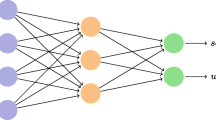Abstract
Constraints are useful to model many real-life problems. Soft constraints are even more useful, since they allow for the use of preferences, which are very convenient in many real-life problems. In fact, most problems cannot be precisely defined by using hard constraints only.
However, soft constraint solvers usually can only take as input preferences over constraints, or variables, or tuples of domain values. On the other hand, it is sometimes easier for a user to state preferences over entire solutions of the problem.
In this paper, we define an interactive framework where it is possible to state preferences both over constraints and over solutions, and we propose a way to build a system with such features by pairing a soft constraint solver and a learning module, which learns preferences over constraints from preferences over solutions. We also describe a working system which fits our framework, and uses a fuzzy constraint solver and a suitable learning module to search a catalog for the best products that match the user's requirements.
Similar content being viewed by others
References
Biso, A., Rossi, F., & Sperduti, A. (2000). Experimental results on learning soft constraints. In Proceedings 7th Int. Conf. on Principles of Knowledge Representation and Reasoning (KR 2000), Morgan Kaufmann.
Bistarelli, S., Montanari, U., & Rossi, F. (1997). Semiring-based constraint solving and optimization. J. ACM 44(2): 201–236.
Burke, R. The Wasabi personal shopper: A case based recommender system. In Proceedings Conference on Innovative Applications in AI.
Codognet, P., & Rossi, F., eds. (2003). Special issue of the Constraints Journal on Soft Constraints. vol. 8, no. 1. Kluwer.
Coletta, R., Bessiere, C., O'sullivan, B., Freuder, E. C., O'Connell, S., & Quinqueton, J. (2003). Semiautomatic modeling by constraint acquisition. In Proceedings Constraint Programming (CP 2003) (short paper), Springer Verlag, LNCS 2833.
Dechter, R. (2003). Constraint Processing. Morgan Kauffmann.
Dubois, D., Fargier, H., & Prade, H. (1993). The calculus of fuzzy restrictions as a basis for flexible constraint satisfaction. In Proceedings of the IEEE International Conference on Fuzzy Systems, IEEE.
Fargier, H., & Lang, J. (1993). Uncertainty in constraint satisfaction problems: A probabilistic approach. In Proceedings of the European Conference on Symbolic and Qualitative Approaches to Reasoning and Un-certainty (ECSQARU), pages 97–104. Springer-Verlag, LNCS 747.
Fargier, H., Lang, J., & Schiex, T. (1993). Selecting preferred solutions in fuzzy constraint satisfaction problems. In Proceedings 1st European Congress on Fuzzy and Intelligent Technologies (EUFIT).
Freuder, E. C., & Wallace, R. J. (1992). Partial constraint satisfaction. Archit. Ironmongery J. 58.
Freuder, E., & Wallace, R. (1998). Suggestion strategies for constraint-based matchmaker agents. In Proceedings Constraint Programming (CP 1998), Springer Verlag, LNCS 1520.
Khatib, L., Morris, P., Morris, R., & Rossi, F. (2001). Temporal constraint reasoning with preferences. In Proceedings International Joint Conference on Artificial Intelligence (IJCAI 2001).
Khatib, L., Morris, P., Morris, R., Rossi, F., & Sperduti, A. (2001). Learning preferences on temporal constraints: A preliminary report. In Proceedings TIME 2001, IEEE Computer Society Press, (June).
Laburthe, F., & Caseau, Y. (2003). Using constraints for exploring catalogs. In Proceedings Constraint Programming (CP 2003), Springer-Verlag, LNCS 2833.
Maes, P., Guttman, R. H., & Moukas, A. G. (1999). Agents that buy and sell. Communication of the ACM 42(3).
Mitchell, T. (1998). Machine Learning. McGraw Hill.
Qu, Y., & Beale, S. (1999). A constraint-based model for cooperative response generation in information dialogues. In Proceedings 16th National Conference on Artificial Intelligence of the American Association for Artificial Intelligence (AAAI 1999), pages 148–155. Morgan Kauffmann.
Rossi, F., & Sperduti, A. (1998). Learning solution preferences in constraint problems. J. Exp. Theor. Artif. Intell. 10.
Rossi, F., & Sperduti, A. (2001). Acquiring both global and local preferences in interactive constraint solving via machine learning techniques. In Proceedings Constraint Programming (CP 2001) Workshop on User-Interaction in Constraint Satisfaction, Cyprus, (December).
Rossi, F., Sperduti, A., Venable, K. B., Khatib, L., Morris, P., & Morris, R. (2002). Learning and solving soft temporal constraints: An experimental study. In Proceedings Constraint Programming (CP 2002), pages 249–263. Springer Verlag, LNCS.
Ruttkay, Zs. (1994). Fuzzy constraint satisfaction. In Proceedings 3rd IEEE International Conference on Fuzzy Systems.
Schiex, T. (1992). Possibilistic constraint satisfaction problems, or “how to handle soft constraints?” In Proceedings 8th Conference of Uncertainty in AI, pages 269–275.
Schiex, T., Fargier, H., & Verfaille, G. (1995). Valued constraint satisfaction problems: Hard and easy problems. In Proceedings International Joint Conference on Artificial Intelligence (IJCAI I995), Morgan Kaufmann.
Shardanand, U., & Maes, P. (1995). Social information filtering algorithms for automating “word of mouth”. In Proceedings Human Factors in Computer Science, ACM.
Author information
Authors and Affiliations
Rights and permissions
About this article
Cite this article
Rossi, F., Sperduti, A. Acquiring Both Constraint and Solution Preferences in Interactive Constraint Systems. Constraints 9, 311–332 (2004). https://doi.org/10.1023/B:CONS.0000049206.43218.5f
Issue Date:
DOI: https://doi.org/10.1023/B:CONS.0000049206.43218.5f




